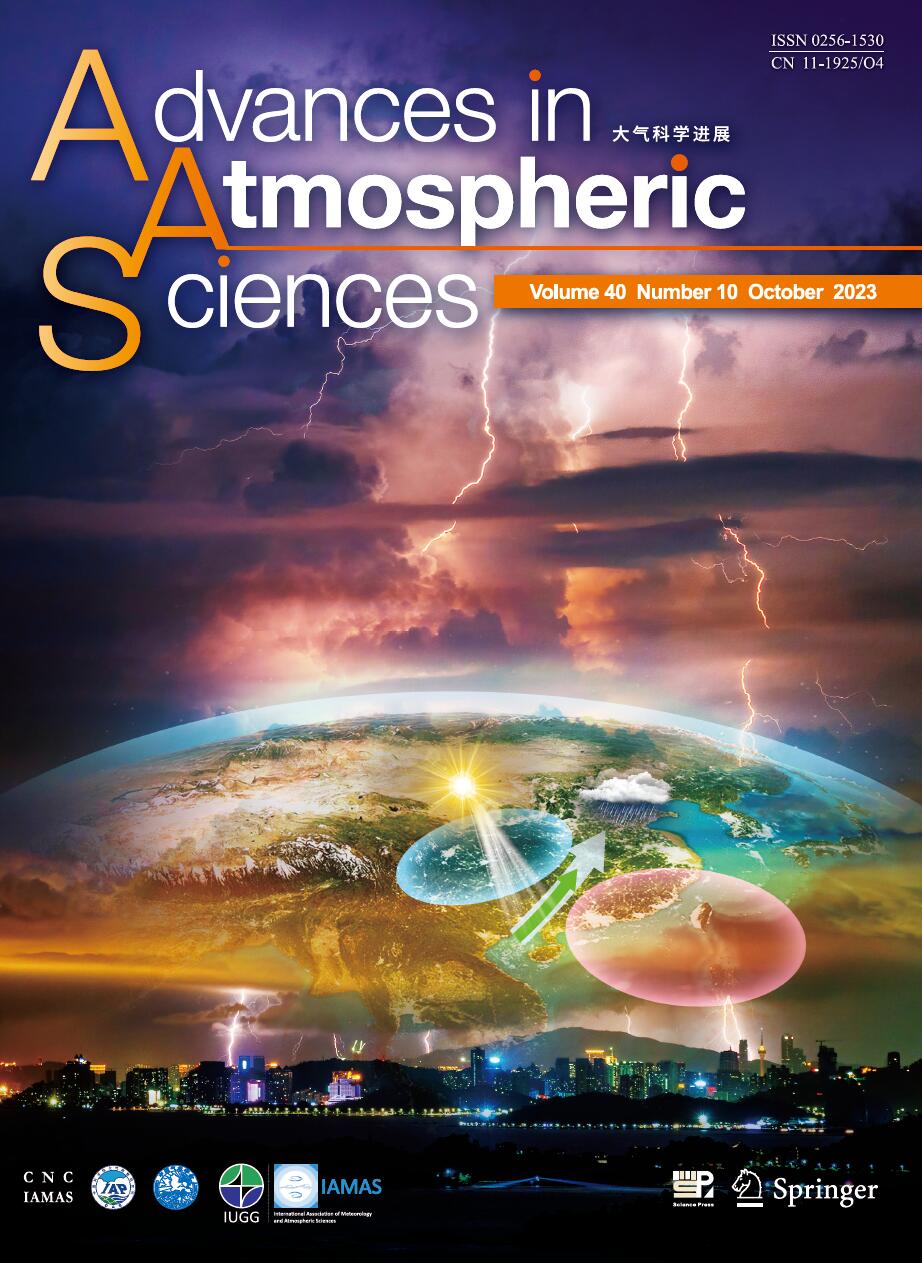| [1] |
WU Shu, WU Lixin, LIU Qinyu, Shang-Ping XIE,
2010: Development Processes of the Tropical Pacific Meridional Mode, ADVANCES IN ATMOSPHERIC SCIENCES, 27, 95-99.
doi: 10.1007/s00376-009-8067-x
|
| [2] |
Xiaoxin WANG, Dabang JIANG, Xianmei LANG,
2018: Climate Change of 4°C Global Warming above Pre-industrial Levels, ADVANCES IN ATMOSPHERIC SCIENCES, 35, 757-770.
doi: 10.1007/s00376-018-7160-4
|
| [3] |
Huang Fei, Zhou Faxiu, Qian Xiaodan,
2002: Interannual and Decadal Variability of the North Pacific Blocking and Its Relationship to SST,Teleconnection and Storm Tracks, ADVANCES IN ATMOSPHERIC SCIENCES, 19, 807-820.
doi: 10.1007/s00376-002-0046-4
|
| [4] |
HAN Leqiong, LI Shuanglin, LIU Na,
2014: An Approach for Improving Short-Term Prediction of Summer Rainfall over North China by Decomposing Interannual and Decadal Variability, ADVANCES IN ATMOSPHERIC SCIENCES, 31, 435-448.
doi: 10.1007/s00376-013-3016-0
|
| [5] |
Yujie JING, Yangchun LI, Yongfu XU, Guangzhou FAN,
2019: Influences of the NAO on the North Atlantic CO2 Fluxes in Winter and Summer on the Interannual Scale, ADVANCES IN ATMOSPHERIC SCIENCES, 36, 1288-1298.
doi: 10.1007/s00376-019-8247-2
|
| [6] |
HUANG Jianping, JI Mingxia, Kaz HIGUCHI, Amir SHABBAR,
2006: Temporal Structures of the North Atlantic Oscillation and Its Impact on the Regional Climate Variability, ADVANCES IN ATMOSPHERIC SCIENCES, 23, 23-32.
doi: 10.1007/s00376-006-0003-8
|
| [7] |
Ni Yunqi, Zhang Qin, Lin Wuyin,
1991: Seasonal Characteristics and Interannual Variability of Monthly Scale Low-Frequency Oscillation in a Low-Order Global Spectral Model, ADVANCES IN ATMOSPHERIC SCIENCES, 8, 307-316.
doi: 10.1007/BF02919613
|
| [8] |
JIANG Zhina, WANG Xin, WANG Donghai,
2015: Exploring the Phase-Strength Asymmetry of the North Atlantic Oscillation Using Conditional Nonlinear Optimal Perturbation, ADVANCES IN ATMOSPHERIC SCIENCES, 32, 671-679.
doi: 10.1007/s00376-014-4094-3
|
| [9] |
YUAN Yuan, C. L. Johnny CHAN, ZHOU Wen, LI Chongyin,
2008: Decadal and Interannual Variability of the Indian Ocean Dipole, ADVANCES IN ATMOSPHERIC SCIENCES, 25, 856-866.
doi: 10.1007/s00376-008-0856-0
|
| [10] |
SUN Jianqi, YUAN Wei,
2009: Contribution of the Sea Surface Temperature over the Mediterranean-Black Sea to the Decadal Shift of the Summer North Atlantic Oscillation, ADVANCES IN ATMOSPHERIC SCIENCES, 26, 717-726.
doi: 10.1007/s00376-009-8210-8
|
| [11] |
Xiaofei WU, Jiangyu MAO,
2019: Decadal Changes in Interannual Dependence of the Bay of Bengal Summer Monsoon Onset on ENSO Modulated by the Pacific Decadal Oscillation, ADVANCES IN ATMOSPHERIC SCIENCES, 36, 1404-1416.
doi: 10.1007/s00376-019-9043-8
|
| [12] |
Xiao DONG, Feng XUE,
2016: Phase Transition of the Pacific Decadal Oscillation and Decadal Variation of the East Asian Summer Monsoon in the 20th Century, ADVANCES IN ATMOSPHERIC SCIENCES, 33, 330-338.
doi: 10.1007/s00376-015-5130-7
|
| [13] |
Jianping LI, Tiejun XIE, Xinxin TANG, Hao WANG, Cheng SUN, Juan FENG, Fei ZHENG, Ruiqiang DING,
2022: Influence of the NAO on Wintertime Surface Air Temperature over East Asia: Multidecadal Variability and Decadal Prediction, ADVANCES IN ATMOSPHERIC SCIENCES, 39, 625-642.
doi: 10.1007/s00376-021-1075-1
|
| [14] |
Guanghui ZHOU, Rong-Hua ZHANG,
2022: Structure and Evolution of Decadal Spiciness Variability in the North Pacific during 2004–20, Revealed from Argo Observations, ADVANCES IN ATMOSPHERIC SCIENCES, 39, 953-966.
doi: 10.1007/s00376-021-1358-6
|
| [15] |
Tiejun XIE, Ji WANG, Taichen FENG, Ting DING, Liang ZHAO,
2023: Linkage of the Decadal Variability of Extreme Summer Heat in North China with the IPOD since 1981, ADVANCES IN ATMOSPHERIC SCIENCES, 40, 1617-1631.
doi: 10.1007/s00376-023-2304-6
|
| [16] |
Kaiming HU, Yingxue LIU, Gang HUANG, Zhuoqi HE, Shang-Min LONG,
2020: Contributions to the Interannual Summer Rainfall Variability in the Mountainous Area of Central China and Their Decadal Changes, ADVANCES IN ATMOSPHERIC SCIENCES, 37, 259-268.
doi: 10.1007/s00376-019-9099-5
|
| [17] |
Li'an Xie, Leonard J.Pietrafesa, Kejian Wu,
2002: Interannual and Decadal Variability of Landfalling Tropical Cyclones in the Southeast Coastal States of the United States, ADVANCES IN ATMOSPHERIC SCIENCES, 19, 677-686.
doi: 10.1007/s00376-002-0007-y
|
| [18] |
Jun LU, Liguang WU, Shunwu ZHOU,
2022: Quantifying the Contribution of Track Changes to Interannual Variations of North Atlantic Intense Hurricanes, ADVANCES IN ATMOSPHERIC SCIENCES, 39, 260-271.
doi: 10.1007/s00376-021-1116-9
|
| [19] |
Kairan YING, Jing PENG, Li DAN, Xiaogu ZHENG,
2022: Ocean–atmosphere Teleconnections Play a Key Role in the Interannual Variability of Seasonal Gross Primary Production in China, ADVANCES IN ATMOSPHERIC SCIENCES, 39, 1329-1342.
doi: 10.1007/s00376-021-1226-4
|
| [20] |
Qiu Yongyan,
1993: On the Seasonal Transition and the Interannual Variability in Global Kinetic Energy at 500 hPa, Accompanied with Anomalies of Energy during the 1982 / 83 ENSO, ADVANCES IN ATMOSPHERIC SCIENCES, 10, 248-256.
doi: 10.1007/BF02919148
|















 AAS Website
AAS Website 
 AAS WeChat
AAS WeChat 
 DownLoad:
DownLoad: